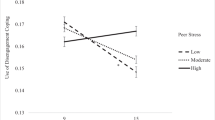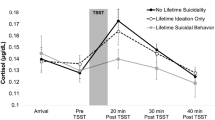Abstract
This study investigated the impact of social stress on symptoms of psychopathology at the entry into adolescence (111 girls, Mage = 11.84, SD = 0.77). We examined whether peer stress and pubertal timing were associated with internalizing distress and aggression, and whether responses to stress and cortisol reactivity mediated or moderated these associations. Cortisol samples were collected from saliva samples during in-home visits, and the YSR was used to assess psychopathology. Interestingly, pubertal timing demonstrated a trend association with cortisol. Responses to stress mediated the association between social stress and symptoms of internalizing distress and aggression. Specifically, early maturers and girls with higher levels of peer stress exhibited more problematic responses to stress, in turn demonstrating higher levels of internalizing distress and aggression. Significant moderation effects also emerged. For example, early maturers who experienced higher levels of emotional/cognitive numbing in response to peer stress were at greater risk for aggression. Findings identify coping strategies that may be used in evidence-based programming to help girls transition more successfully into adolescence will be discussed.





Similar content being viewed by others
Notes
A complete list of tasks is available from the author.
Comparing the sample at the original assessment to the assessment used in this study, there was a loss of 19.5% of the sample of girls. The authors conducted univariate analyses of non-response bias to determine if the remaining sample differed on key demographic factors, pubertal development variables, and outcomes (depression, peer problems, internalizing and externalizing behavior) assessed at baseline. Results showed that participants did not differ on variables used in this study.
In addition to AUCcortisol, the authors conducted preliminary multi-level analyses to examine whether or not patterns of change over time in cortisol were associated with symptoms of psychopathology. Results indicated that pattern of change was not associated with internalizing distress or aggression, suggesting that the multi-level analyses added no additional information to the study beyond what AUCcortisol demonstrated. A complete description of the multi-level analyses is available upon request.
References
Achenbach, T. M. (1991). Manual for the Youth Self-Report and 1991 Profile. Burlington: Department of Psychiatry, University of Vermont.
Angold, A. (2003). Adolescent depression, cortisol, and DHEA. Psychological Medicine, 33, 573–581 Medline. DOI 10.1017/S003329170300775X.
Baron, R. M., & Kenny, D. A. (1986). The moderator-mediator variable distinction in social psychological research: conceptual, strategic, and statistical considerations. Journal of Personality and Social Psychology, 51, 1173–1182 Medline. DOI 10.1037/0022-3514.51.6.1173.
Belsky, J., Steinberg, L. D., Houts, R. M., Friedman, S. L., DeHart, G., Cauffman, E., et al. (2007). Family rearing antecedents of pubertal timing. Child Development, 78, 1302–1321 Medline. DOI 10.1111/j.1467-8624.2007.01067.x.
Brooks-Gunn, J. (1991). How stressful is the transition to adolescence for girls. In M. E. Colten, & S. Gore (Eds.), Adolescent stress: causes and consequences (pp. 131–149). New York: Aldine de Gruyter.
Caspi, A., Lynam, D., Moffitt, T. E., & Silva, P. A. (1993). Unraveling girls' delinquency: Biological, dispositional, and contextual contributions to adolescent misbehavior. Developmental Psychology, 29, 19–30. DOI 10.1037/0012-1649.29.1.19.
Chan, W. (2003). Analyzing ipsative data in psychological research. Behaviormetrika, 30, 99–121. DOI 10.2333/bhmk.30.99.
Chumlea, W. C., Schubert, C. M., Roche, A. F., Kulin, H. E., Lee, P. A., Himes, J. H., et al. (2003). Age at menarche and racial comparisons in US girls. Pediatrics, 111, 110–113 Medline. DOI 10.1542/peds.111.1.110.
Cicchetti, D., & Walker, E. F. (2001). Stress and development: Biological and psychological consequences. Development and Psychopathology, 13, 413–418 Medline. DOI 10.1017/S0954579401003017.
Coie, J. D., Dodge, K. A., & Kupersmidt, J. B. (1990). The role of poor peer relationships in the development of disorder. In S. R. Asher, & J. D. Coie (Eds.), Peer rejection in childhood (pp. 274–305). New York: Cambridge University Press.
Compas, B. E., Connor, J. K., Saltzman, H., Thomsen, A. H., & Wadsworth, M. (1999). Getting specific about coping: Effortful and involuntary responses to stress in development. In M. Lewis, & D. Ramsay (Eds.), Soothing and stress (pp. 229–256). Mahwah: Erlbaum.
Compas, B. E., Connor-Smith, J. K., Saltzman, H., Thomsen, A. H., & Wadsworth, M. (2001). Coping with stress during childhood and adolescence: Problems, progress, and potential in theory and research. Psychological Bulletin, 127, 87–127 Medline. DOI 10.1037/0033-2909.127.1.87.
Connor-Smith, J. K., Compas, B. E., Wadsworth, M. E., Thomsen, A. H., & Saltzman, H. (2000). Responses to stress in adolescence: measurement of coping and involuntary stress responses. Journal of Consulting and Clinical Psychology, 68, 976–992 Medline. DOI 10.1037/0022-006X.68.6.976.
Costello, E. J., Foley, D. L., & Angold, A. (2006). Ten-year research update review: The epidemiology of child and adolescent psychiatric disorders: II. developmental epidemiology. Journal of the American Academy of Child and Adolescent Psychiatry, 45, 8–25 Medline. DOI 10.1097/01.chi.0000184929.41423.c0.
Cunningham, W. H., Cunningham, I. C. M., & Green, R. T. (1977). The ipsative process to reduce response set bias. Public Opinion Quarterly, 41, 379–384. DOI 10.1086/268394.
Deater-Deckard, K. (2001). Annotation: Recent research examining the role of peer relationships in the development of psychopathology. Journal of Child Psychology and Psychiatry, 42, 565–579 Medline. DOI 10.1017/S0021963001007272.
Ge, X., Brody, G. H., Conger, R. D., Simons, R. L., & Murry, V. M. (2002). Contextual amplification of pubertal transition effects on deviant peer affiliation and externalizing behavior among African American children. Developmental Psychology, 38, 42–54 Medline. DOI 10.1037/0012-1649.38.1.42.
Ge, X., Conger, R. D., & Elder, G. H. (2001). Pubertal transition, stressful life events, and the emergence of gender differences in adolescent depressive symptoms. Developmental Psychology, 37, 404–417 Medline. DOI 10.1037/0012-1649.37.3.404.
Graber, J. A. (2003). Puberty in context. In C. Hayward (Ed.), Gender differences at puberty (pp. 307–321). New York: Cambridge University Press.
Graber, J. A., Brooks-Gunn, J., & Archibald, A. B. (2005). Links between girls' puberty and externalizing and internalizing behaviors: moving from demonstrating effects to identifying pathways. In D. M. Stoff, & E. J. Susman (Eds.), Developmental psychobiology of aggression. New York: Cambridge University Press.
Graber, J. A., Brooks-Gunn, J., & Warren, M. P. (2006). Pubertal effects on adjustment in girls: Moving from demonstrating effects to identifying pathways. Journal of Youth and Adolescence, 35, 391–401. DOI 10.1007/s10964-006-9049-2.
Graber, J. A., Seeley, J. R., Brooks-Gunn, J., & Lewinsohn, P. M. (2004). Is pubertal timing associated with psychopathology in young adulthood? Journal of the American Academy of Child and Adolescent Psychiatry, 43, 718–726 Medline. DOI 10.1097/01.chi.0000120022.14101.11.
Graber, J. A., & Sontag, L. M. (2008). Internalizing problems during adolescence. In R. M. Lerner, L. Steinberg (Eds.), Handbook of adolescent psychology, 2nd Edn. New York: Wiley, in press.
Granger, D. A., Weisz, J. R., & Kauneckis, D. (1994). Neuroendocrine reactivity, internalizing behavior problems, and control-related cognitions in clinic-referred children and adolescents. Journal of Abnormal Psychology, 103, 267–276 Medline. DOI 10.1037/0021-843X.103.2.267.
Grant, K. E., & Compas, B. E. (2003). Stressors and child and adolescent psychopathology: Moving from markers to mechanisms of risk. Psychological Bulletin, 129(3), 447–466 Medline. DOI 10.1037/0033-2909.129.3.447.
Gunnar, M. R. (2000). Early adversity and the development of stress reactivity and regulation. In C. A. Nelson (Ed.), The effects of adversity on neurobehavioral development: The Minnesota Symposia on Child Psychology (vol. 31, (pp. 163–200)). Mahwah: Erlbaum.
Gunnar, M. R., & Vazquez, D. M. (2001). Low cortisol and a flattening of expected daytime rhythm: Potential indices of risk in human development. Development & Psychopathology, 13, 515–538 Medline. DOI 10.1017/S0954579401003066.
Herman-Giddens, M. E., Slora, E. J., Wasserman, R. C., Bourdony, C. J., Bhapkar, M. V., Koch, G. G., et al. (1997). Secondary sexual characteristics and menses in young girls seen in office practice: a study from the pediatric research in office settings network. Pediatrics, 99, 505–512 Medline. DOI 10.1542/peds.99.4.505.
Igram, R. E., & Luxton, D. D. (2005). Vulnerability-stress models. In B. L. Hankin, & J. R. Z. Abela (Eds.), Development of psychopathology: a vulnerability-stress perspective (pp. 32–46). Thousand Oaks: Sage.
Jaser, S. S., Langrock, A. M., Keller, G., Merchant, M. J., Benson, M., Reeslund, K., et al. (2005). Coping with the stress of parental depression II: adolescent and parent reports of coping and adjustment. Journal of Clinical Child and Adolescent Psychology, 34, 193–205 Medline. DOI 10.1207/s15374424jccp3401_18.
Kendall-Tackett, K. A. (2000). Physiological correlates of childhood abuse: chronic hyperarousal in PTSD, depression, and irritable bowel syndrome. Child Abuse and Neglect, 24, 799–810 Medline. DOI 10.1016/S0145-2134(00)00136-8.
Klimes-Dougan, B., Hastings, P. D., Granger, D. A., Usher, B. A., & Zahn-Waxler, C. (2001). Adrenocortical activity in at-risk and normally developing adolescents: Individual differences in salivary cortisol basal levels, diurnal variation, and responses to social challenges. Development & Psychopathology, 13, 695–719 Medline. DOI 10.1017/S0954579401003157.
La Greca, A. M. (2001). Friends or foes? Peer influences on anxiety among children and adolescents. In W. K. A. T. Silverman, & P. D. A. Treffers (Eds.), Anxiety disorders in children and adolescents: research, assessment and intervention (pp. 159–186). Cambridge: Cambridge University Press.
Lazarus, R. S., & Folkman, S. (1984). Stress, appraisal, and coping. New York: Springer.
Marshall, W. A., & Tanner, J. M. (1969). Variations in the pattern of pubertal changes in girls. Archives of Disease in Childhood, 44, 291–303 Medline.
Nansel, T. R., Craig, W., Overpeck, M. D., Saluja, G., & Ruan, W. J. (2004). Cross-national consistency in the relationship between bullying behaviors and psychosocial adjustment. Archives of Pediatric & Adolescent Medicine, 158, 730–736 Medline. DOI 10.1001/archpedi.158.8.730.
Oosterlaan, J., Geurts, H. M., Knol, D. L., & Sergeant, J. A. (2005). Low basal salivary cortisol is associated with teacher-reported symptoms of conduct disorder. Psychiatry Research, 134, 1–10 Medline. DOI 10.1016/j.psychres.2004.12.005.
Preacher, K. J., & Hayes, A. F. (2006). Asymptotic and resampling strategies for assessing and comparing indirect effects in simple and multiple mediator models. Manuscript submitted for publication, may be accessed at: http://www.comm.ohio-state.edu/ahayes/indirect2.pd.
Rovine, M. J., von Eye, A., & Wood, P. (1988). The effect of low covariate criterion correlations on the analysis-of-covariance. In E. Wegmen (Ed.), Computer science and statistics: Proceedings of the 20th symposium of the interface (pp. 500–504). Alexandria, VA: American Statistical Association.
Rudolph, K. D. (2002). Gender differences in emotional responses to interpersonal stress during adolescence. Journal of Adolescent Health, 30, 3–13 Medline. DOI 10.1016/S1054-139X(01)00383-4.
Rudolph, K., Dennig, M. D., & Weisz, J. R. (1995). Determinants and consequences of children’s coping in the medical setting: Conceptualization, review, and critique. Psychological Bulletin, 118, 328–357 Medline. DOI 10.1037/0033-2909.118.3.328.
Schmidt, L. A., Fox, N. A., Sternberg, E. M., Gold, P. W., Smith, C. C., & Schulkin, J. (1999). Adrenocortical reactivity and social competence in seven year-olds. Personality and Individual Differences, 26, 977–985. DOI 10.1016/S0191-8869(98)00099-3.
Schwartz, E. B., Granger, D. A., Susman, E. J., Gunnar, M. R., & Laird, B. (1998). Assessing salivary cortisol in studies of child development. Child Development, 69, 1503–1513 Medline. DOI 10.2307/1132128.
Sobel, M. E. (1982). Asymptotic intervals for indirect effects in structural equations models. In S. Leinhart (Ed.), Sociological methodology 1982 (pp. 290–312). San Francisco: Jossey-Bass.
Stroud, L. R., Papandonatos, G. D., & Williamson, D. (2004). Sex differences in the effects of pubertal development on responses to a corticotropin-releasing hormone challenge: the Pittsburgh Psychobiologic Studies. In R. E. Dahl, & L. P. Spear (Eds.), Adolescent brain development: vulnerabilities and opportunities (pp. 348–351). New York: New York Academy of Sciences.
Wadsworth, M. E., Raviv, T., Compas, B. E., & Connor-Smith, J. K. (2005). Parent and adolescent responses to poverty-related stress: tests of mediated and moderated coping models. Journal of Child and Family Studies, 14, 283–298. DOI 10.1007/s10826-005-5056-2.
Weichold, K., Silbereisen, R. K., & Schmitt-Rodermund, E. (2003). Short-term and long-term consequences of early versus late physical maturation in adolescents. In C. Hayward (Ed.), Gender differences at puberty (pp. 241–276). New York: Cambridge University Press.
Weisberg, H. I. (1979). Statistical adjustments and uncontrolled studies. Psychological Bulletin, 86, 1149–1164.
Acknowledgements
The research reported in this paper was supported by grants from the National Institute of Child Health and Human Development and the National Institute of Mental Health.
Author information
Authors and Affiliations
Corresponding author
Rights and permissions
About this article
Cite this article
Sontag, L.M., Graber, J.A., Brooks-Gunn, J. et al. Coping with Social Stress: Implications for Psychopathology in Young Adolescent Girls. J Abnorm Child Psychol 36, 1159–1174 (2008). https://doi.org/10.1007/s10802-008-9239-3
Received:
Accepted:
Published:
Issue Date:
DOI: https://doi.org/10.1007/s10802-008-9239-3




